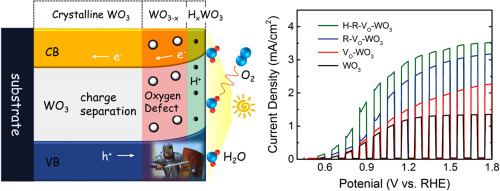Nano Energy ( IF 17.6 ) Pub Date : 2018-09-19 , DOI: 10.1016/j.nanoen.2018.09.019 Zhenao Gu , Le Zhang , Bo Wen , Xiaoqiang An , Huachun Lan , Li-Min Liu , Tao Chen , Jing Zhang , Xingzhong Cao , Junwang Tang , Huijuan Liu , Jiuhui Qu

|
Establishing effective strategies to boost the separation of interfacial charge carriers is necessary to address the limiting bottlenecks of photocatalysis. Although oxygen vacancy modulation has become the prevalent strategy to improve the photoactivity, controversy persists regarding the real role of these defects in charge separation. To exert the great potential of nonstoichiometric semiconductors, one needs not only to establish a full atomistic picture of oxygen vacancies, but also to deliberate their possible interactions with other interfacial structures (represented by the ubiquitous intercalated hydrogen). Herein, WO3 was used as a typical model to demonstrate the principle of hydrogen-intercalated nonstoichiometric oxides for photoelectrochemical water splitting. Both experimental characterizations and theoretical calculations evidenced the synergetic interactions between oxygen vacancies and intercalated hydrogen. The sequential formation of subsurface defect clusters and surface O–H bonds contributed significantly to the spatial separation of charge carriers and the impressive stability of nonstoichiometric photoanodes. Profiting from this principle, an unprecedented photocurrent of 2.94 mA cm−2 at 1.23 V vs. RHE was achieved, apart from a 100 mV cathodic shift in the onset potential. Our principle is applicable to several semiconductors, e.g. TiO2 and Fe2O3. Thus, it opens up a promising avenue into designing high-performance nonstoichiometric nanoarchitectures for a wide range of applications. The termination-dependent surface reactivity also provides new opportunities of reactive species modulation for high-performance photocatalysis.
中文翻译:

氢嵌入非化学计量氧化物中界面电荷分离的有效设计原理
建立有效的策略来促进界面电荷载体的分离对于解决光催化的瓶颈是必要的。尽管氧空位调节已成为提高光活性的普遍策略,但是关于这些缺陷在电荷分离中的真正作用仍存在争议。为了发挥非化学计量半导体的巨大潜力,不仅需要建立完整的原子氧原子原子图,还需要研究它们与其他界面结构(以无处不在的嵌入氢表示)的可能相互作用。在此,WO 3以典型的模型来证明氢插入的非化学计量氧化物在光电化学水分解中的原理。实验表征和理论计算均证明了氧空位与嵌入氢之间的协同作用。次表面缺陷簇和表面OH键的顺序形成对电荷载流子的空间分离和非化学计量光阳极的令人印象深刻的稳定性做出了重要贡献。得益于此原理,除了起始电势有100 mV的阴极移位外,在相对于RHE的1.23 V下,实现了前所未有的2.94 mA cm -2的光电流。我们的原理适用于几种半导体,例如TiO 2和Fe 2 O3。因此,它为设计用于广泛应用的高性能非化学计量纳米体系结构开辟了一条有希望的途径。依赖终止的表面反应性还为高性能光催化提供了反应物种调节的新机会。


























 京公网安备 11010802027423号
京公网安备 11010802027423号